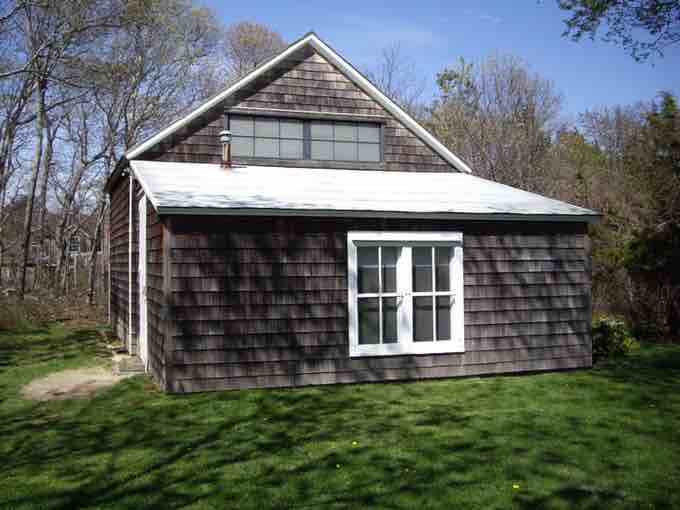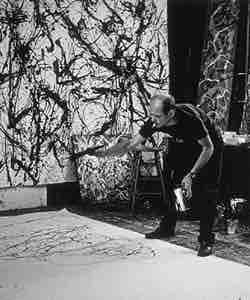Action Painting
Action painting is a style of painting in which paint is spontaneously dribbled, splashed or smeared onto the canvas, rather than being carefully applied with a brush. The resulting work often emphasizes the physical act of painting itself as an essential aspect of the finished work. Action painting is inextricably linked to Abstract Expressionism, a school of painting popular in post–World War II America that was characterized by the view that art is non-representational and chiefly improvisational. Major artists associated with this movement are Jackson Pollock, Willem de Kooning, Robert Motherwell, Franz Kline and Mark Rothko, among others.
The term action painting was coined by the American art critic Harold Rosenberg in 1952 in his essay "The American Action Painters", signalling a major shift in the aesthetic perspective of New York School painters and critics. According to Rosenberg the canvas was not an object, but rather "an arena in which to act. " Rosenberg's critique shifted the emphasis from the object to the struggle of painting itself, with the finished work being only the physical manifestation, a kind of residue, of the actual work of art, which was in the process of the painting's creation.
Action painting refers to the spontaneous activity that was the "action" of the painter, through arm and wrist movement, painterly gestures, leading to paint that was thrown, splashed, stained, splattered, poured, and dripped . The painter would sometimes let the paint drip onto the canvas while rhythmically dancing or even while standing on top of the unstretched canvas laying on the floor—both techniques invented by one of the most important abstract expressionists: Jackson Pollock.
Jackson Pollock
My painting does not come from the easel. I prefer to tack the unstretched canvas to the hard wall or the floor. I need the resistance of a hard surface. On the floor I am more at ease. I feel nearer, more part of the painting, since this way I can walk around it, work from the four sides, and literally be in the painting.
Born in Cody, Wyoming in 1912, Jackson Pollock moved to New York City in 1930, where he studied under Thomas Hart Benton at the Art Students League of New York. In 1948 he married American painter Lee Krasner, and they moved to what is now known as the Pollock-Krasner House and Studio in the Springs area of East Hampton, Long Island, NY.

The Pollock Barn
Pollock's studio in Springs, New York.
Materials and Process
After his move to Springs, he began painting with his canvases laid out on the studio floor, turning to synthetic resin-based paints called alkyd enamels, which were much more fluid than traditional paint and, at that time, were a novel medium. Pollock described this use of household paints, instead of fine art paints, as "a natural growth out of a need. " He used hardened brushes, sticks, and even basting syringes as paint applicators. By defying the convention of painting on an upright surface, he added a new dimension by being able to view and apply paint to his canvases from all directions—the term "all-over painting" has been used to describe some of his work, as well as the work of other artists from that time. In the process of making paintings in this way, he moved away from figurative representation, and challenged the Western tradition of using easel and brush. In addition, he also moved away from the use of only the hand and wrist, since he used his whole body to paint .

Jackson Pollock in his studio
The artist threw, splashed, stained, splattered, poured and dripped paint to create his works.
Titles with Numbers
Pollock wanted an end the search for figurative elements in his paintings, so he abandoned titles and started numbering his paintings instead. The numbering relates to the way composers title their works. Furthering the musical metaphor, Pollock's action paintings have been often described as improvisational works of art, similar to how jazz musicians approach the performance of a piece.
Death
At the peak of his fame, Pollock abruptly abandoned the drip style and by 1951 his works had turned darker in color. This was followed by a return to color, and he reintroduced figurative elements. During this period Pollock had moved to a more commercial gallery and there was great demand from collectors for new paintings. In response to this pressure, along with personal frustration, his long-term problem with alcoholism worsened. He painted his two last works in 1955. On August 1956 Pollock died in a single-car crash in his Oldsmobile convertible while driving under the influence of alcohol. After Pollock's demise at age 44, his widow, Lee Krasner, managed his estate and ensured that Pollock's reputation remained strong despite changing art-world trends. They are both buried in Green River Cemetery in Springs, Long Island, NY.